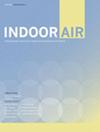一种评价和消除家用空调真菌污染的方法
IF 4.3
2区 环境科学与生态学
Q1 CONSTRUCTION & BUILDING TECHNOLOGY
引用次数: 0
摘要
背景。过敏性真菌气道疾病,如哮喘和过敏性支气管肺真菌病(ABPM),往往难以单靠药物治疗;因此,应准确评估和减少环境真菌暴露。在本研究中,我们建立了一种评估和消除家用空调真菌污染的方法。方法。2020年秋季,对日本17名ABPM或相关疾病患者的住宅进行了起居室环境调查。拆卸家用无管道微型分体式交流机组,从内部部件(过滤器、热交换器、鼓风机和通风口)收集拭子样本,然后进行高压洗涤。采用定量PCR和新一代测序技术分别测定了棉子样品和空调清洁废水以及室内灰尘和空气样品中的真菌丰度和组成。计算加权UniFrac距离来分析样品间真菌群落的相似性。结果。空调的所有内部部件都含有高水平的真菌DNA,鼓风机是污染最严重的部件。在AC装置中检出最多的真菌是枝孢菌和毒枝孢菌,其次是小孢子菌、曲霉和红托菌。高压洗涤使所有交流部位的真菌丰度降低了99%以上。风机中的真菌丰度和组成与清洁废水中的真菌丰度和组成密切相关。结论。家用空调换热器下游的室内部分是真菌污染的主要场所,可能会污染住宅室内空气。高压清洗对去污非常有效。本文章由计算机程序翻译,如有差异,请以英文原文为准。
A Method to Evaluate and Eliminate Fungal Contamination in Household Air Conditioners
Background. Allergic fungal airway diseases, such as asthma and allergic bronchopulmonary mycosis (ABPM), are often difficult to manage with medical treatment alone; therefore, environmental fungal exposure should be accurately evaluated and minimized. In the present study, we established a method to evaluate and eliminate fungal contamination in household air conditioners (ACs). Methods. In the fall of 2020, an environmental survey of living rooms was conducted in 17 Japanese residences of patients with ABPM or related diseases. Household ductless minisplit AC units were disassembled to collect swab samples from the internal parts (filter, heat exchanger, blower fan, and air vent), followed by high-pressure washing. Fungal abundance and composition in swab samples and cleaning effluents of ACs as well as house dust and air samples were determined using quantitative PCR and next-generation sequencing of the internal transcribed spacer 1 region, respectively. A weighted UniFrac distance was calculated to analyze the similarity of the mycobiome among the samples. Results. All interior parts of ACs contained high levels of fungal DNA, with the blower fans being the most contaminated parts. Cladosporium and Toxicocladosporium, followed by Aureobasidium, Aspergillus, and Rhodotorula, were the most common fungi detected in the AC unit. High-pressure washing decreased fungal abundance by over 99% in all AC parts. Fungal abundance and composition in blower fans were strongly correlated with those in cleaning effluents. Conclusion. Interior parts downstream of heat exchangers in household ACs are the major sites of fungal contamination, possibly polluting the indoor air in the residences. High-pressure washing is highly effective for decontamination.
求助全文
通过发布文献求助,成功后即可免费获取论文全文。
去求助
来源期刊

Indoor air
环境科学-工程:环境
CiteScore
10.80
自引率
10.30%
发文量
175
审稿时长
3 months
期刊介绍:
The quality of the environment within buildings is a topic of major importance for public health.
Indoor Air provides a location for reporting original research results in the broad area defined by the indoor environment of non-industrial buildings. An international journal with multidisciplinary content, Indoor Air publishes papers reflecting the broad categories of interest in this field: health effects; thermal comfort; monitoring and modelling; source characterization; ventilation and other environmental control techniques.
The research results present the basic information to allow designers, building owners, and operators to provide a healthy and comfortable environment for building occupants, as well as giving medical practitioners information on how to deal with illnesses related to the indoor environment.
 求助内容:
求助内容: 应助结果提醒方式:
应助结果提醒方式:


